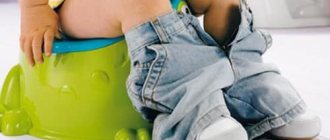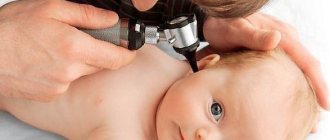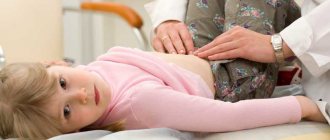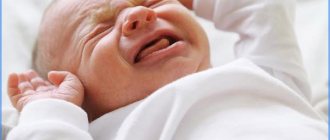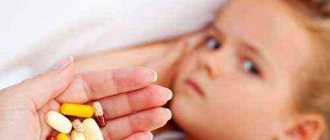Diarrhea in young children is a common occurrence, causing a lot of trouble for parents and considerable discomfort for the baby. This condition is not always harmless and can cause unpleasant complications. Diarrhea in a 2-year-old child should be perceived as a serious disruption to the functioning of a small organism, requiring adults to take effective measures.
Diarrhea, diarrhea in a 2 year old child, causes and treatment
Diarrhea or diarrhea means bowel movements more than two to three times a day with a change in the consistency of the stool (it becomes liquid).
The causes of diarrhea are disturbances in the functioning of the intestines: poor absorption by the walls of the large intestine, inflammation of the intestines. So what can cause diarrhea and frequent loose stools in 2-year-old children? Various factors can contribute to the appearance of diarrhea in a child at the age of two:
— errors in diet;
- various types of infections;
- use of certain medications.
The content of the article:
Temperature with disorder
When diarrhea and fever develop, there are two reasons why this is possible. Firstly, the condition may develop due to the penetration of an infectious pathogen, and secondly, indigestion may affect the thermometer readings.
What to do if, in addition to diarrhea, you have a high fever? Antipyretics can be given. It is important to exclude viral infections. If the baby is already suffering from this type of disease, it is necessary to consult a doctor and, possibly, adjust the course of treatment.
Even if you feed your baby only the freshest food, it is impossible to protect against indigestion. A young body may react incorrectly to the introduction of a new product into the diet. All unpleasant symptoms in this case pass quickly and without the use of special means.
We must not forget that white diarrhea, with foam and high temperature cannot be ignored. It is necessary to call a doctor or an ambulance at home as soon as possible.
Causes of diarrhea in a child aged 2 years
Based on the factors that caused frequent loose stools in a child, diarrhea can be neurogenic, dyspeptic, toxic, infectious, nutritional and medicinal.
Liquid feces of an infectious nature are found with shigellosis (dysentery), salmonellosis, food poisoning and other similar diseases. Rotovirus infection, which occurs in young children, also has similar symptoms. Rotovirus infection is characterized by an acute onset of diarrhea: gag reflex, weakening of the body, diarrhea. However, along with the above symptoms, abdominal pain and fever are not observed. The main danger of infectious liquid bowel movements in a two-year-old child is severe loss of fluid, which contributes to rapid dehydration of the child’s body. In connection with this circumstance, the baby’s parents are obliged to take all measures to restore the loss of water and salt in the body. The rest of the treatment is prescribed by the doctor after the initial examination of the patient with an examination.
The most common diarrhea among two-year-old children is nutritional diarrhea. Factors influencing its occurrence include: errors in diet, allergies to any type of food, excessive feeding, etc. Dyspeptic diarrhea or dyspeptic diarrhea in a baby can develop due to disturbances in the functioning of the liver, pancreas, and intestines. With these pathologies, the secretion of gastrointestinal enzymes decreases, and digestive difficulties appear.
In addition to the reasons described above, diarrheal bowel movements in two-year-old children can be caused by psychological reasons, for example, strong emotions, fear, anxiety, stress, etc. If diarrhea in a 2-year-old child does not go away within a day, you urgently need to consult a doctor, who will determine the root cause of the baby’s liquid stool and prescribe effective treatment. When diarrhea lasts for a sufficiently long period, it can take a chronic form, in which almost every meal is accompanied by liquid feces. In this case, the baby’s metabolic process begins to be disrupted and there is a special need for vitamins, minerals, proteins and other microelements that are very important for normal life.
Causes of gastrointestinal disorders
The causes of diarrhea in a 2-year-old child can be either minor nutritional errors or serious congenital or acquired anomalies of the body. For convenience, etiological factors are conventionally divided into two groups - infectious and non-infectious.
Contagious causes include:
- Severe infections such as dysentery, cholera. Infections are extremely rare under normal conditions. However, a trip to the countries of Asia, Africa, and the East can give such an unpleasant “souvenir”.
- Food poisoning caused by salmonella, Staphylococcus aureus, E. coli, mold fungi. They can be found in low-quality, undercooked food products, as well as on dirty hands, toys, and household items.
- Rotavirus infections tend to circulate in kindergartens in the spring and autumn.
The carrier of the infection can release pathogens even when treatment is completed and there are no clinical signs of the disease.
Non-contagious causes of diarrhea may include:
- Therapy with antibiotics that cause dysbiosis and weakening of the intestines.
- Crohn's disease is an autoimmune lesion of the gastrointestinal tract with the occurrence of granulomas, erosions, and ulcers. This category also includes other gastrointestinal diseases that are becoming increasingly common at such a tender age.
- Poisoning by mushrooms, poisonous plants, heavy metal salts, insect repellents, medications. Poor supervision of children during walks, leaving chemicals, thermometers, and medications in an accessible place is criminal carelessness of parents. The baby will pull a beautiful berry into his mouth and open the bright packaging.
- Diseases associated with metabolic disorders - gluten and lactose intolerance, thyroid abnormalities, diabetes.
- Nutritional errors – fatty, fried, spicy, smoked, pickled foods. A 2-year-old child has diarrhea as a result of overeating, especially chocolate, chips, cakes and other goodies. The same reaction is caused by eating incompatible foods, for example, herring and milk.
- It is quite possible for a two-year-old sensitive child to have diarrhea after stress, anxiety, or excitement.
- Allergy to certain foods.
Only qualified medical personnel in a hospital setting can accurately determine the cause of diarrhea in a 2-year-old child, after conducting a series of studies and evaluating test results.
What other causes of diarrhea in childhood can there be?
Diarrhea in childhood is the most common problem and there are many reasons for this. Often, bowel dysfunction in a small child can occur against a background of high fever. In this case, most parents prefer to reduce the temperature with antipyretic drugs based on glycerin, which also helps to liquefy the stool. Among the most likely causes of diarrhea in children are the following:
1 intestinal infections caused by various pathogenic microorganisms: bacteria, viruses, fungi;
2 helminthic infestations;
3 infectious diseases that are accompanied by high body temperature;
4 disturbances in the functioning of the digestive tract and liver;
5 unbalanced diet;
6 consumption of expired products;
7 side effect from taking medications;
8 medication overdose;
9 nervous tension, stress;
10 diseases requiring immediate surgical intervention, for example, inflammation of the appendix, volvulus and others.
One-time diarrhea is not a reason to panic if the baby’s general well-being does not cause concern. But if the situation repeats repeatedly, then the child should be shown to a specialist.
Sometimes the causes of diarrhea in childhood are not a mystery to parents - the child may eat a large amount of heavy food or foods to which he has an individual intolerance. However, in most cases, the cause lies much deeper, so it is impossible to do without competent medical diagnosis. Let's take a closer look at the possible causes of bowel dysfunction in preschool children:
1 Eating disorders. A child’s imperfect digestive system can react with the appearance of diarrhea to the consumption of difficult-to-digest food, especially in large quantities. In the same way, products that he has not tried before also affect the baby’s body. Such diarrhea is usually isolated in nature and may be accompanied by flatulence, bloating, minor pain and nausea. A child may develop diarrhea after eating fruits and vegetables that have not undergone heat treatment, as well as foods that are too fatty or sour. Some products may not be compatible with each other, which will also negatively affect the functioning of the gastrointestinal tract.
Features of the digestive tract in children by 3 years of age
By the age of 3, the baby’s digestive system is underdeveloped. The volume of the stomach at birth in newborns is only 7 ml; by the age of three it increases to 400–500 ml. The gastrointestinal tract has a vulnerable mucous membrane. Elastic and muscle tissues are poorly developed. And also, in children under 3 years of age, the secretory function is underdeveloped (a small amount of gastric juice with a low content of enzymes is secreted).
Such features of the digestive tract complicate the process of assimilation of certain foods, especially if it is not suitable for the child’s age. As a result, the protective function of the gastrointestinal tract is weakened, which leads to frequent diseases.
Diarrhea, diarrhea and vomiting in a two-year-old child
In children aged two years, diarrhea with vomiting can occur as a result of overfeeding, an incorrectly composed daily menu, or taking certain types of medications. During this period of child development, cases of infectious diarrhea are quite common. At this age, children are actively exploring their environment, including tasting and licking various objects. They carry out these actions because, due to their age, they do not yet know the rules of personal hygiene. As a result of examining various objects, bacteria, food not intended for his age, or spoiled foods enter the child’s body.
Food poisoning is manifested by gag reflexes, nausea, liquid bowel movements with mucus, and a sudden deterioration in the child’s condition. Regarding body temperature, it can either be elevated or remain normal (which is most often observed). If all these signs are detected, you must definitely call a doctor in order to establish a diagnosis and prescribe a course of treatment.
Diarrhea and fever, chills, causes of diarrhea with fever
Diarrhea accompanied by fever in two-year-old children is most often evidence of rotavirus infection. This infection can be transmitted through the fecal-oral route. This disease is characterized by a sharp acute onset, elevated body temperature, loose bowel movements, abdominal pain, vomiting, poor health, and dehydration.
Fever in 2-year-old children can also occur as a result of infection with helminths, intestinal infections, poisoning, etc. Cold-type diseases with complications are accompanied by similar symptoms. In addition to colds, the same symptoms are observed with scarlet fever, measles, and rubella.
What should not be done for acute diarrhea?
Acute diarrhea refers to frequent diarrhea with a greenish tint and traces of blood, combined with vomiting, high fever and severe abdominal pain. In this case, it is strictly forbidden to do the following:
- Give your child antibiotics and other medications for diarrhea.
- Massage your stomach and apply a warm heating pad to it.
- Give your baby any painkillers.
- Forcing a child to eat food if he or she has no appetite.
In case of acute diarrhea, it is recommended to immediately call an ambulance. And before the specialists arrive, give the baby boiled water (in small portions).
Diarrhea, diarrhea with mucus in a 2 year old child, causes
The main causes of diarrhea, severe and frequent diarrhea with mucus, when the stool contains mucous secretions in children two years old, are considered to be rotavirus, enterovirus, salmonella, lamblia and other harmful microorganisms. If a child has an acute form of diarrhea with watery contents in the stool, it is necessary to urgently call emergency help. These symptoms indicate an acute intestinal infection or poisoning. The presence of a small amount of mucous mass in the stool may indicate a nutritional disorder or the penetration of harmful microorganisms into the body.
Folk remedies
Treatment of childhood diarrhea using folk remedies is gentle and effective. There are many ways to stop diarrhea in a child.
Carrot puree
You will need to boil several carrots (3-4 pieces) in their peels, then peel, mash and add a small amount of boiled water to the resulting mass. The child is given 2 tablespoons of prepared puree 4 times during the day.
Chicory flower infusion
This remedy is applicable even in infancy. The product exhibits pronounced astringent and antimicrobial properties. A teaspoon of dry raw materials is poured into 0.5 liters of water and boiled for at least 5 minutes. After cooling, the drink is given to the baby with a 2-hour break (1 teaspoon each).
Wild pear decoction with oats
This product can be used to treat children from 12 months. Several ripe wild pear fruits (not garden pears) are cut into small pieces, mixed with 3 tablespoons of oatmeal, pour in 0.5 liters of water and cook for 20 minutes. After this, the medicinal composition is poured into a clean glass vessel, wrapped in a warm blanket and kept for an hour. The strained mixture is given to the child in the amount of 50-100 g 3-4 times during the day on an empty stomach.
Mixture of grape seeds and honey
Grape seeds collected in the fall must be dried and ground. Next, you should mix them in equal proportions with natural honey. A small amount of the product is given to the child on an empty stomach and before meals three times a day.
What to do if your child has diarrhea?
When diarrhea appears in a 2-year-old child, you should immediately remember that you need to first prevent dehydration. The child must be under constant adult supervision. If your condition worsens, you must call an ambulance. Remember that only a doctor can prescribe treatment based on the individual characteristics of the baby’s body!
When treating diarrhea in a child, it is necessary to give fluids frequently and in larger quantities than usual. The water should be salted or diluted with Regidron, Citroglucosan. It is not recommended to give juices, lemonades, and soda during this period. If your baby's frequent and loose stools are caused by dysfunction of the gastrointestinal tract, the doctor may prescribe Bifiform, Bificol, Bifidumbacterin, Lactobacterin.
The greatest danger with diarrhea is dehydration, so the main emphasis should be on restoring the water-salt balance. Regarding drug treatment, consultation with a specialized specialist is required, since parents, as a rule, are not able to independently identify the cause of the disease. It is not recommended to use traditional methods of treatment at such a young age, for example, pomegranate peels, decoctions and infusions of medicinal herbs. Treatment of a child should be to eliminate its cause, because diarrhea is just a symptom.
Treatment of diarrhea in a child under two years of age must be carried out in compliance with certain rules:
1 large drink. The child should be offered a teaspoon of something to drink at room temperature every 5-10 minutes, since dehydration occurs very quickly at this age;
2 minimum food. The baby should be fed food that is easy on the stomach and should not be forced under any circumstances if the child refuses to eat;
3 taking absorbent drugs. At this age, doctors recommend using Enterosgel, which will help remove all toxic substances from the body as quickly as possible.
When providing first aid, it is necessary to constantly monitor the baby’s well-being; if it begins to deteriorate, the body temperature rises, the child becomes lethargic, the feces become light in color, then it is necessary to urgently seek medical help.
If the child is quite active, the diarrhea does not contain blood or pus, and the cause of diarrhea lies in an unbalanced diet, then treatment can be carried out at home, but it is still better to see a specialist. At the same time, after each act of defecation, it is necessary to wash the baby to avoid irritation. It is advisable to collect stool in a separate container and deliver it to the laboratory for testing, which will eliminate the infectious nature of the disease.
Frequent bowel movements or upset
Every mother naturally worries about her baby and when he has frequent bowel movements, he immediately decides to take him to the doctor. But is it always worth worrying so much, because frequent trips to the toilet do not mean that the child has diarrhea. Diarrhea is primarily loose stool.
And if your baby has normal bowel movements, not runny, and he feels great, although he went to the toilet a little more than usual, then he is unlikely to have a disorder. The frequency of your child's stool may be greater, depending on what he ate. Therefore, doctors advise paying attention first of all to the consistency of the stool and the general condition of the baby.
Diet, how to eat properly when a child has diarrhea?
For the period of treatment of diarrhea in a two-year-old toddler, it is recommended to follow a certain diet for some time. The following products are allowed on the daily menu:
1 White bread in the form of croutons (no more than 200 g). Other baked goods are prohibited.
2 Light fish or meat soups with meatballs, egg flakes, ground meat. The cereals allowed in the soup are rice, pearl barley, and semolina.
3 Steam cutlets and meatballs, soufflé. Non-fat varieties of meat are permissible.
4 Soft-boiled eggs or steam omelet. No more than one egg is allowed daily.
6 Boiled vegetable products.
7 From liquids, teas, fruit drinks, pure water, and some types of juices (diluted with water) are allowed. Plum, grape, and apricot juices are prohibited.
You should stick to the diet until diarrhea and its accompanying symptoms disappear completely.
Source
What to do and what to feed a 2-year-old child with diarrhea?
Children who have changed their status from infants to the proud title of preschool children are very vulnerable to diseases of the digestive system. Food becomes varied and not always healthy. Active socialization (attending kindergarten, crowded social events) significantly expands the child’s social circle. The number of contacts with carriers of various infections is increasing. The baby learns about the world around him and puts everything into his mouth. A complex of predisposing factors creates favorable conditions for frequent diarrhea in a 2-year-old child.
About the problem
saliva is designed to destroy microbes at the stage of entry into the mouth, bronchial and nasal mucus protect the respiratory organs from bacteria and viruses, gastric juice effectively destroys those microorganisms that managed to enter the body through the mouth and reach the digestive organs unharmed. Bacteria, which are the indigenous inhabitants, await “uninvited guests” in the intestines. Their task is to prevent malicious agents from taking root.
Some viruses, such as rotavirus, also cause diarrhea. The intestinal mucosa is an excellent breeding ground for their reproduction, and therefore digestion is disrupted, the intestinal mucosa is irritated and diarrhea occurs.
Symptoms of diarrhea in young children
For babies up to 3-4 months, loose, frequent stools are normal. Loose stools more than 3 times a day in a 2-year-old child are considered diarrhea. A child may have diarrhea without fever. At the same time, the baby complains of pain and cramping in the abdomen, associated with rumbling and increased gas production. Unpleasant phenomena intensify after each meal. Such an upset stomach and intestines causes a refusal to eat, the child is capricious and does not sleep well. Prolonged debilitating diarrhea leads to a decrease in the amount of urine, crying without tears, poor skin tone, that is, signs of dehydration. The baby is lethargic, weak, does not want to eat, and is tormented by thirst.
With temperature comes a process caused by infections. In this case, symptoms increase quickly. If loose stools are accompanied by vomiting, the body loses a lot of fluid at once. This is a very dangerous condition that threatens the life of the baby. A sharp deterioration in the child’s well-being, detection of blood, pus in liquid stool, green, yellow or other unnatural color of stool signals that it is necessary to seek urgent medical help.
How to tell if your baby is dehydrated
Doctors distinguish several degrees of dehydration:
1st degree
Loss of 1-3% fluid from body weight. The baby is worried, stools 3-5 times a day, vomiting is possible once, it stops when the child is soldered with aqueous solutions.
2nd degree
4-6% is lost, the lips are dry, there is a white coating on the tongue, the patient is inactive, skin peeling, thirst appears, the skin becomes pale, the blush disappears from the cheeks. Diarrhea up to 10 times a day, repeated vomiting.
3rd degree
The deficiency is 7-9%, can only be relieved in a hospital under the supervision of a doctor. Up to 15 bowel movements, profuse vomiting, dry mucous membranes and skin, the child is thirsty and extremely sleepy.
4th degree – the most critical – over 10%
Such children require resuscitation measures and may be unconscious. Pale skin with a bluish tint, skin cold to the touch.
Treatment of diarrhea in a two-year-old child
Treatment of diarrhea in a child aged 2 years begins with identifying the cause of the digestive disorder. If poisoning is clearly visible, you need to drink boiled water and induce vomiting by pressing on the root of the tongue until the stomach is completely cleansed. For any etiology of diarrhea, replenish fluid loss with plenty of warm drink. This is weak sweet tea, dried apple compote, rosehip infusion, or just boiled water. You can give your child regdrants from the pharmacy.
Fixative medications that can stop diarrhea are Smecta powder and activated charcoal. Sometimes it is worth using folk remedies - rice broth, as well as decoctions of pomegranate peels and St. John's wort. When using herbal remedies, be careful because of possible allergies in your child. A decoction of St. John's wort increases skin sensitivity to the sun; fair-skinned children experience sunburn.
An important step on the path to recovery will be a diet that is gentle on the stomach and intestines for babies. The first step is to exclude intolerable foods that cause diarrhea. They can be fruits, fresh milk, and vegetables that may seem healthy at first glance. Digestive enzymes are present in the baby in insufficient quantities, so not all food is digested. Feed your child rice, semolina, and buckwheat porridge with water. Let's have some boiled, baked potatoes. Protein products include steamed omelette, lean boiled chicken without skin. During diarrhea, fresh fruits, vegetables and juices are prohibited. Avoid milk and milk products for now. Of course, no sweets, snacks, soda, sausages, or fast food. Pamper your child with dry, inconvenient cookies and biscuits.
Prevention
The health of a little person should be under the constant supervision of adults. The age of two years is characterized by active movement, learning about the world and at the same time the absence of fear, the concept of danger. Parents are advised to heed the following advice:
- The transition from mother's milk and children's pureed porridges and purees to adult food is carried out gradually. New foods are introduced into the baby’s diet one at a time, in small portions. At the same time, they monitor the reaction - whether there is a rash, abdominal discomfort, or intestinal symptoms.
- Teach your child to wash their hands before eating and after a walk. Do not give unwashed fruits, berries, and vegetables.
- Explain to relatives the dangers of overfeeding. Expressing your love for your baby with an abundance of sweets, snacks and other unhealthy goodies is extremely unwise. In addition to digestive disorders, there is a risk of metabolic disorders and obesity.
- Develop a culture of proper, healthy eating in your family and follow a daily routine. Watch your diet, because the child takes an example from the life of his parents.
- Avoid visiting clinics during mass epidemics; it is better to call a doctor at home.
- Spend more time outdoors. Leisure in shopping and entertainment centers promotes unintentional contacts with a wide range of people.
- The slightest deviations in children's health become a reason for a visit to the clinic. If the disease is caught at an early stage, it is much easier to treat.
The foundations of proper nutrition and a healthy lifestyle are laid in early childhood. Adults bear full responsibility for shaping the life principles of a little person. There must be a worthy example before the eyes of the child, otherwise all wise advice will remain empty words.
Diarrhea in a two-year-old child occurs for differentiated reasons and is accompanied by symptoms of varying intensity. Regardless of the etiology of the process, the main action for diarrhea is to restore water and salt balance and prevent dehydration. Developing healthy habits and strengthening the immune system will protect your baby from many diseases in the future.
Source
Danger of diarrhea
The most serious danger of diarrhea lies in the possibility of dehydration. The younger the child, the higher this risk. Potassium, calcium, and sodium salts, which are extremely important for life, are released with feces. Fluid is rapidly lost. Therefore, it is not as scary if a 3-year-old child goes to the toilet five times a day and does not show signs of dehydration as if five times diarrhea happened to a 6-month-old baby. After all, the baby’s reserves of water and mineral salts are much more meager, and he loses them at a faster rate.
